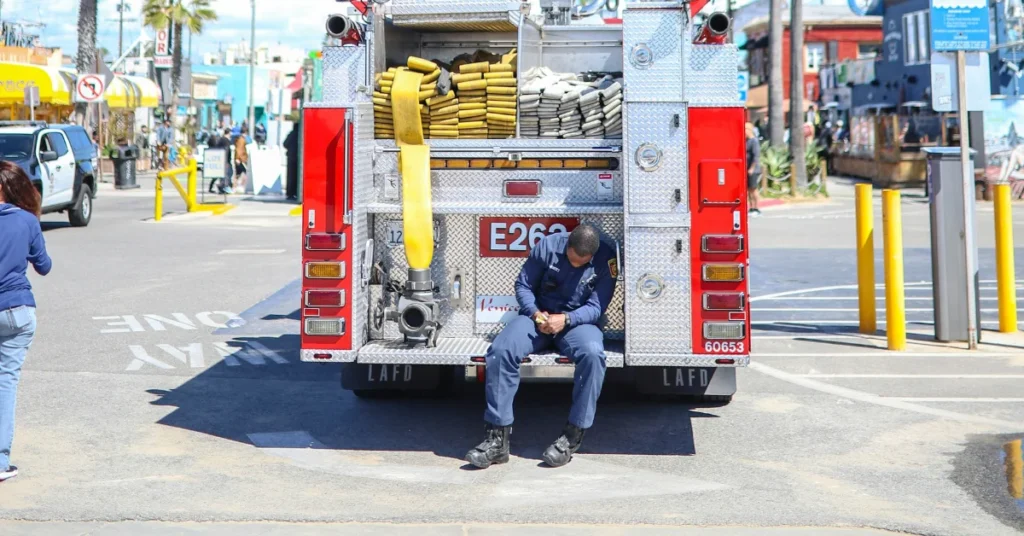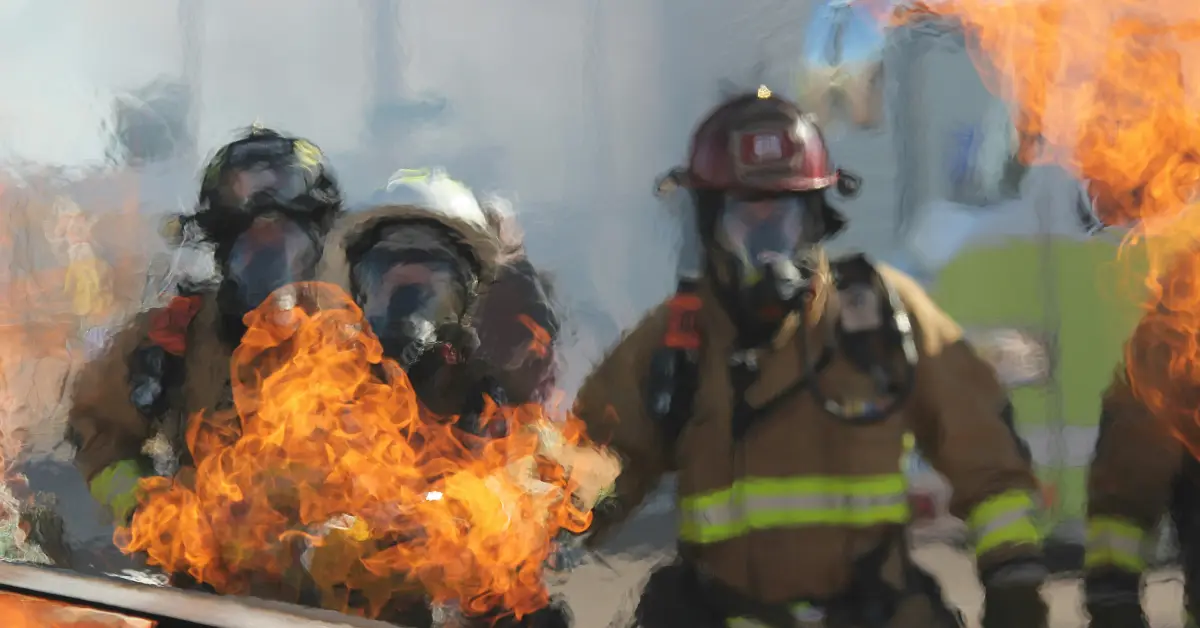Ready to turn up the heat on your fitness goals this year? Discover the intense yet effective regimen of the Firefighter Workout. With routines inspired by the bravery and endurance of firefighters, this training will push you to new limits while sculpting strength and resilience. Embrace the challenge and ignite your 2025 fitness routine today.
Foundations of Firefighter Fitness
It’s not just about having muscles—it’s about functional strength and stamina that can literally save lives.
Strength Training: It’s essential to build a strong foundation. I incorporate strength training exercises that enhance my ability to lift, carry, and maneuver through challenging environments. I prioritize compound movements like squats, deadlifts, and overhead presses to work on multiple muscle groups at once.
Endurance: A firefighter’s job isn’t just a sprint; it’s a marathon with obstacles. There are fire operations that can take several hours to get the job done. For this, I work tirelessly to boost my endurance. I mix high-intensity interval training (HIIT) with longer, steady-state cardio sessions. Running, cycling, or even loaded marches are a great way to ensure my heart and lungs are up for the task.
Weekly Fitness Schedule
I would recommend this weekly fitness plan if you start with the firefighter training. In the beginning, it’s crucial to build that endurance and to ensure that you remain as flexible as possible to prevent injuries.
- Monday: Full-body Strength Training
- Wednesday: HIIT Training
- Friday: Endurance Cardio
- Sunday: Active Recovery, Stretching, or Yoga
Once your body has become accustomed to the strain, you can expand the training plan like in the following schedule
- Monday: Full-body Strength Training
- Wednesday: HIIT Training
- Thursday: Active Recovery, Stretching, or Yoga
- Friday: Endurance Cardio
- Saturday: Full-body Strength Training
- Sunday: HIIT Training
With each day dedicated to a specific aspect of fitness, we ensure that the routine is balanced and comprehensive. It’s not just about being fit; it’s about preparing for every scenario we might encounter.
My advice to fellow firefighters is simple: find a routine that challenges you, keeps you engaged, and most importantly—prepares you for the unexpected. Remember, our physical prowess must match the demands of the job, so let’s commit to being the fittest we can be.
Essential Workout Components

When I look at designing effective workout programs, my focus is on creating routines that enhance core stability, cardiovascular endurance, functional strength, and explosive power. These components are critical for first responders, enabling them to perform at their best while ensuring safety and reducing the risk of injuries.
Developing Core Strength
Strengthening the core is crucial for any first responder. A solid core enhances balance, stability, and overall strength, which are vital for tasks like lifting, carrying, and extrication activities. Planks, squats, and deadlifts are key exercises I incorporate into my routine to build a sturdy core.
Building Cardiovascular Endurance
Cardiovascular health is non-negotiable. High endurance levels allow for extended periods of exertion, critical during search and rescue operations. My go-to methods include sustained rowing sessions and rigorous treadmill workouts. Incorporating stair climbs into training enhances my performance specifically for firefighting scenarios.
Enhancing Functional Performance
Functional strength is about more than just muscle; it’s about how well I can apply power during on-the-job activities. Exercises like medicine ball slams and box jumps improve my balance, coordination, and agility, which are essential during unpredictable situations like navigating uneven terrain during a callout.
High-Intensity Training Strategies
High-Intensity Interval Training (HIIT) is integral to simulating the bursts of activity required in the field. My firefighter workout routine includes circuit intervals, alternating between exercises like medicine ball slams, intense box jumps, and short but fierce cardio segments. This approach pushes my limits and dramatically increases my fitness level.
Recovery and Injury Prevention

I can’t stress enough how crucial recovery and injury prevention are in this workout routine! First off, let’s talk about rest. Remember, it’s as important as the workout itself because it’s when my body repairs and strengthens itself. No skimping on downtime!
Now, onto foam rolling, my secret weapon for keeping muscles happy. Rolling out after exercise helps me reduce muscle soreness and enhances my range of motion. Plus, it’s like giving myself a good muscle massage, and who wouldn’t love that?
Incorporating yoga a few times a week has been a game-changer for me. It elevates my flexibility, supports my joints, and keeps my mind centered. Trust me, those deep stretches and mindful breaths work wonders!
Solid sleep is non-negotiable. I aim for 7-9 hours to let my body fully recuperate. It’s amazing how a good night’s rest can leave me feeling ready to tackle blazes and rescue drills with gusto.
Nutrition and Lifestyle for Peak Performance

Ensuring peak performance in firefighting isn’t just about rigorous workout routines; it’s deeply rooted in a balanced diet, mental well-being, and a structured fitness regimen. My main focus here is to shed light on the essentials of optimal nutrition, the importance of mental health, and the vitality of a long-term, adaptable workout strategy.
Fueling the Firefighter’s Body
I understand the importance of a diet that matches the high demands of a firefighter. Prioritizing whole foods rich in nutrients and managing caloric intake to support intense activities is crucial. Here’s a simple breakdown:
- Pre-Workout: Quick absorption of carbs and proteins, like yogurt or fruit, is my go-to before tackling the day’s physical challenges.
- Post-Workout: After training, I focus on recovery. Replenishing with lean proteins and complex but less carbs, such as grilled chicken and brown rice, helps repair muscles and restore energy levels.
In terms of hydration, I never underestimate the power of water. Remaining diligently hydrated is a constant goal throughout my day, especially after a sweat-inducing workout.
Mental Health and Community Support
I recognize that a strong mind is just as important as a fit body. Balancing the mental and physical aspects has significantly boosted both my motivation and resilience. Here’s what works for me:
- Daily Reflection: Finding time for reflection helps me manage stress.
- Community Interaction: Whether it’s with fellow firefighters or a support group, talking and sharing experiences strengthens my emotional health.
Building a Sustainable Workout Plan
A truly effective workout plan for a firefighter needs to be dynamic and adaptable. Here’s how I maintain my progress:
- Diverse Fitness Programs: I incorporate a mix of cardio, strength, and flexibility to avoid hitting a plateau.
- Realistic Goals: Setting attainable, yet challenging, goals keeps me focused. My current objective? Increase endurance by 10% this quarter.
- Consultation with a Fitness Trainer: I periodically check in with my trainer to tailor my fitness journey, ensuring my workout program always aligns with my specific role demands and fitness level.
I know that a life as firefighter is always busy and it’s hard to find a fitness trainer that you can incorporate easily into your daily routine. But have you heard of the possibility of getting instructed by a virtual fitness trainer? No? Then have a look at the linked blog article.
FAQ
What is a firefighter workout?
A firefighter workout is a specialized fitness regimen designed to enhance the strength, endurance, and agility required for firefighting tasks, such as carrying heavy equipment, climbing ladders, and rescuing individuals.
What exercises are included in a firefighter workout?
Typical exercises include strength training (e.g., squats, deadlifts), cardio (e.g., running, stair climbing), functional movements (e.g., rope climbs, tire flips), and flexibility exercises (e.g., yoga, stretching).
Why is a firefighter workout important?
A firefighter workout helps improve overall physical fitness, reducing the risk of injury on the job, enhancing job performance during emergencies, and ensuring firefighters can meet the demanding physical challenges of their duties effectively.
If you liked this blog post about the topic: firefighter workout, don’t forget to leave us a comment down below to tell us about your experience with it. And don’t forget to follow us on Pinterest so you don’t miss any more Diet and Fitness content.





